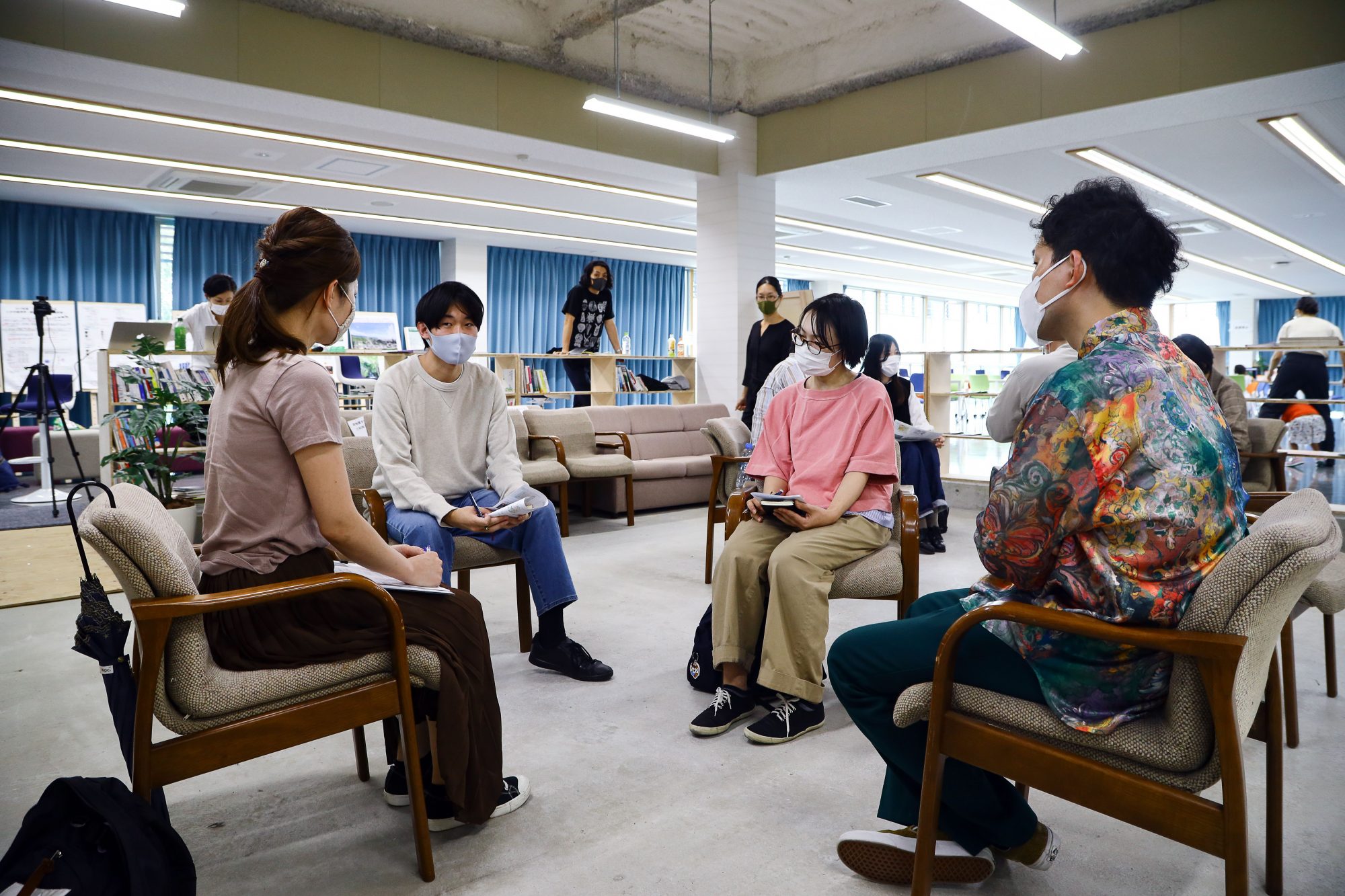REPORTS
- ワークショップ
ジェームズ・ムリウキ 往復書簡プロジェクト「Round-trip Letters」1-2 from プロジェクトメンバー
Editor: ジェームズ・ムリウキ プロジェクトメンバー

REPORTS
Editor: ジェームズ・ムリウキ プロジェクトメンバー

プログラム2「表現編」の招聘アーティスト/キュレーターである、ケニア在住のジェームズ・ムリウキとオンラインで展開する往復書簡プロジェクト「Round-trip Letters」。当初は奈良でフィールドリサーチやレクチャーの実施を予定していましたが、新型コロナウイルスの感染拡大により渡航・入国が困難となっている現在、遥か遠くに暮らすジェームズに、ケニアの状況や今考えていること、プロジェクトの構想について手紙にしたためてもらい、プロジェクトメンバーと文通を行いながらプロジェクトを遠隔で進めていくことになりました。前回のジェームズからの手紙を受け、プロジェクトメンバーからの返信を公開します。
手紙を送ってくださり、ありがとうございます。ケニアの社会的・文化的な状況や、あなたの作品のテーマとヴィジュアルのイメージ、そして新型コロナウイルスの影響によってプロジェクトに変更が生じたことなどを知ることができて、とても興味深かったです。より理解を深めるために、いくつか質問をしてもよいでしょうか。
Thank you for sending your letter. It was very interesting to know the social and cultural situation in Kenya, themes and visual images of your artworks, and changes occurring in your project strongly influenced by the Covid-19 spreading. We have a favor to ask some questions for more profound understanding.
Question 1: 手紙に書かれていたマンチェスター大学との共同プロジェクトに関する下記の一文ですが、あまり充分には意味をつかむことができませんでした。 They would be asked to provide audio records, video records using their smartphones and/or photographs of specific interventions they find as alterations to what they have experienced before. この「specific interventions they find as alterations to what they have experienced before」という箇所ですが、具体的には新型コロナウイルスの流行後に、ライフスタイルが変化したことを意味しているのでしょうか。
Question 1: There is a sentence about your collaborative project with University of Manchester, of which we cannot fully understand the meaning as below. They would be asked to provide audio records, video records using their smartphones and/or photographs of specific interventions they find as alterations to what they have experienced before. Does the words “specific interventions they find as alterations to what they have experienced before” especially mean changes of lifestyle after the spread of a Covid-19?
もしそうなら、新型コロナが広まってから、あなたの日常ではどんな変化がありましたか。日本でも、外では常にマスクをしたり、空間や物や手をいつも消毒したり、互いにソーシャルディスタンスを心がけたり、客と店員の間には透明なプラスチックの板が置かれたりなど、たくさんの変化があります。
In that case, what kind of changes you have experienced in your daily life after the spreading? Here in Japan, we also find a lot of changes: people always wear masks outside their home, clean and disinfect spaces, tools and their hands everytime, ensure social distancing with each other, and you find clear plastic sheets separating customers and clerks anywhere, etc…

Question 2: たくさんのケニアのアーティストや芸術関係者が、新型コロナウイルス拡大後に助成金が一時保留されたりなど、困難な状況におかれたと述べていましたが、アーティストに対する支援はあるのでしょうか。たとえば、ケニア政府からアーティストへの経済的支援などありましたか。政府によるものでも、それ以外の組織でも良いので、ケニアのアーティストに対する緊急支援のイニシアチブがあれば教えてください。
Question 2: Though you mentioned many Kenyan artists and cultural producers have experienced difficult conditions in that grants were put on hold after the spread of Covid-19, are there any supports to the artists? For example, has the Kenyan government offer financial resources to artists? Please let us know about any kind of emergency initiatives to the Kenyan artists by governmental or non-governmental institutions.
Question 3: 日本におけるアートプロジェクトは、社会の成長志向に対抗するものとして機能する傾向があります。今回のコロナ禍は、社会の中で人間にとって大事な物事を改めて見つめ直すきっかけを人々に与えています。その意味で、アートプロジェクトが人々からより理解されやすくなったり、今後より求められるものになると感じています。一方でケニアは発展途上国のため、多くの人が先進国のように成長社会の実現を夢見ていると思いますが、ケニアの成長志向に対して、あなたはどのような生活あるいは作品をこれから実践していきたいですか。
Question 3: Art projects in Japan tend to function as a counter to the growth-oriented society. The Covid-19 pandemic gives people an opportunity to reconsider what is important to human beings in society. In that sense, we feel that art projects will become easier for people to understand and will become more demanding in the future. On the other hand, since Kenya is a developing country, we think that many people dream of realizing a growing society like developed countries. How do you see Kenyan future and what kind of life or work would you want to practice in response to Kenya’s growth orientation?
Question 4: ケニアは新型コロナ以前でさえ政治的・社会的な危機を何度も経験してきていると思います。例えば、2007年から2008年にかけての大統領選の政治暴動の際、平和のグラフィティなどがナイロビのあちこちでたくさん制作されたと思います。コロナの前と後とで、ケニアにおいてアートが果たす役割に違いはあると思いますか。
Question 4: We think Kenya has experienced many political and social crises even before the pandemic. For example, during the political riots in the 2007-2008 presidential election, a lot of peace graffiti was produced around Nairobi. Do you think there is a difference in the role that art plays in Kenya before and after the covid-19?
Question 5: 実現しなかったプロポーザルのアイデアはケニアの人たちだけが対象ですか、それとも世界中の全員ですか。参加者はアパートに密集して暮らしている人に限定しているということですか。そうだとしたら、なぜ他の暮らし方をしている階層の人は対象にはしないのでしょうか。
Question 5: Is the idea for the unrealized proposal targeted at only Kenyans or everyone in the world? Do you mean that the participants are limited to those who live in a crowded apartment? If so, why don’t you target at people in other lifestyles?
もっとこのプロジェクトについて理解したいと思っていますので、プロポーザル全文を見せてもらうことはできますか。
We would like to see the full text of the proposal, if possible, for more general and fudamental understanding.
あなたのお返事を楽しみに待っています。 どうかお体お気をつけて。
We are looking forward to your reply. Please take a good care of yourself.
米田陣(文化芸術による社会課題の解決に関心がある関西学院大学4年生) 西尾美也(美術家/奈良県立大学准教授/CHISOU ディレクター) 西尾咲子(アートマネージャー/京都市立芸術大学ギャラリー@KCUA学芸員/CHISOU プログラムマネージャー) 野田智子(アートマネージャー/アートコレクティヴNadegata Instant Partyメンバー/CHISOU プログラムコーディネーター)
Jin Yoneda (fourth-year student of Kwansei Gakuin University, interested in seeking solutions to social issues through arts and culture) Yoshinari Nishio (artist / associate professor of Nara Prefectural University / director of CHISOU) Sakiko Nishio (art manager / curator of @KCUA / program manager of CHISOU) Tomoko Noda (art manager / member of Nadegata Instant Party / program coordinator of CHISOU)
LECTURE OUTLINE
ジェームズ・ムリウキ
※オンラインでのプロジェクトを展開予定
1977年ケニア生まれ、同在住。ナイロビを拠点にアーティストやキュレーターとして活動。写真や映像、サウンド、インスタレーションなどの多様なメディアを用いて、急速に発展する都市空間の変容を捉えた作品は国内外で展示・収蔵されている。